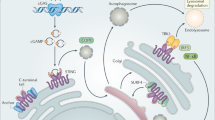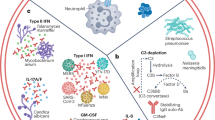Abstract
Atopic dermatitis is a chronic inflammatory skin disease that affects 15–30% of children and approximately 5% of adults in industrialized countries1. Although the pathogenesis of atopic dermatitis is not fully understood, the disease is mediated by an abnormal immunoglobulin-E immune response in the setting of skin barrier dysfunction2. Mast cells contribute to immunoglobulin-E-mediated allergic disorders including atopic dermatitis3. Upon activation, mast cells release their membrane-bound cytosolic granules leading to the release of several molecules that are important in the pathogenesis of atopic dermatitis and host defence4. More than 90% of patients with atopic dermatitis are colonized with Staphylococcus aureus in the lesional skin whereas most healthy individuals do not harbour the pathogen5. Several staphylococcal exotoxins can act as superantigens and/or antigens in models of atopic dermatitis6. However, the role of these staphylococcal exotoxins in disease pathogenesis remains unclear. Here we report that culture supernatants of S. aureus contain potent mast-cell degranulation activity. Biochemical analysis identified δ-toxin as the mast cell degranulation-inducing factor produced by S. aureus. Mast cell degranulation induced by δ-toxin depended on phosphoinositide 3-kinase and calcium (Ca2+) influx; however, unlike that mediated by immunoglobulin-E crosslinking, it did not require the spleen tyrosine kinase. In addition, immunoglobulin-E enhanced δ-toxin-induced mast cell degranulation in the absence of antigen. Furthermore, S. aureus isolates recovered from patients with atopic dermatitis produced large amounts of δ-toxin. Skin colonization with S. aureus, but not a mutant deficient in δ-toxin, promoted immunoglobulin-E and interleukin-4 production, as well as inflammatory skin disease. Furthermore, enhancement of immunoglobulin-E production and dermatitis by δ-toxin was abrogated in KitW-sh/W-sh mast-cell-deficient mice and restored by mast cell reconstitution. These studies identify δ-toxin as a potent inducer of mast cell degranulation and suggest a mechanistic link between S. aureus colonization and allergic skin disease.
This is a preview of subscription content, access via your institution
Access options
Subscribe to this journal
Receive 51 print issues and online access
$199.00 per year
only $3.90 per issue
Buy this article
- Purchase on Springer Link
- Instant access to full article PDF
Prices may be subject to local taxes which are calculated during checkout




Similar content being viewed by others
References
Williams, H. & Flohr, C. How epidemiology has challenged 3 prevailing concepts about atopic dermatitis. J. Allergy Clin. Immunol. 118, 209–213 (2006)
Elias, P. M. & Steinhoff, M. “Outside-to-inside” (and now back to “outside”) pathogenic mechanisms in atopic dermatitis. J. Invest. Dermatol. 128, 1067–1070 (2008)
Liu, F. T., Goodarzi, H. & Chen, H. Y. IgE, mast cells, and eosinophils in atopic dermatitis. Clin. Rev. Allergy Immunol. 41, 298–310 (2011)
Galli, S. J. & Tsai, M. IgE and mast cells in allergic disease. Nature Med. 18, 693–704 (2012)
Rudikoff, D. & Lebwohl, M. Atopic dermatitis. Lancet 351, 1715–1721 (1998)
Leung, D. Y., Walsh, P., Giorno, R. & Norris, D. A. A potential role for superantigens in the pathogenesis of psoriasis. J. Invest. Dermatol. 100, 225–228 (1993)
Supajatura, V. et al. Differential responses of mast cell Toll-like receptors 2 and 4 in allergy and innate immunity. J. Clin. Invest. 109, 1351–1359 (2002)
Selander, C., Engblom, C., Nilsson, G., Scheynius, A. & Andersson, C. L. TLR2/MyD88-dependent and -independent activation of mast cell IgE responses by the skin commensal yeast Malassezia sympodialis. J. Immunol. 182, 4208–4216 (2009)
Schmaler, M. et al. Lipoproteins in Staphylococcus aureus mediate inflammation by TLR2 and iron-dependent growth in vivo. J. Immunol. 182, 7110–7118 (2009)
Wang, R. et al. Identification of novel cytolytic peptides as key virulence determinants for community-associated MRSA. Nature Med. 13, 1510–1514 (2007)
Kretschmer, D. et al. Human formyl peptide receptor 2 senses highly pathogenic Staphylococcus aureus. Cell Host Microbe 7, 463–473 (2010)
Novick, R. P. Autoinduction and signal transduction in the regulation of staphylococcal virulence. Mol. Microbiol. 48, 1429–1449 (2003)
Morfeldt, E., Tegmark, K. & Arvidson, S. Transcriptional control of the agr-dependent virulence gene regulator, RNAIII, in Staphylococcus aureus. Mol. Microbiol. 21, 1227–1237 (1996)
Sugiyama, Y. et al. Changes in the agr locus affect enteritis caused by methicillin-resistant Staphylococcus aureus. J. Clin. Microbiol. 47, 1528–1535 (2009)
Cogen, A. L. et al. Selective antimicrobial action is provided by phenol-soluble modulins derived from Staphylococcus epidermidis, a normal resident of the skin. J. Invest. Dermatol. 130, 192–200 (2010)
Yamada, N., Matsushima, H., Tagaya, Y., Shimada, S. & Katz, S. I. Generation of a large number of connective tissue type mast cells by culture of murine fetal skin cells. J. Invest. Dermatol. 121, 1425–1432 (2003)
Wershil, B. K., Wang, Z. S., Gordon, J. R. & Galli, S. J. Recruitment of neutrophils during IgE-dependent cutaneous late phase reactions in the mouse is mast cell-dependent. Partial inhibition of the reaction with antiserum against tumor necrosis factor-alpha. J. Clin. Invest. 87, 446–453 (1991)
Nilsson, I. M., Hartford, O., Foster, T. & Tarkowski, A. Alpha-toxin and gamma-toxin jointly promote Staphylococcus aureus virulence in murine septic arthritis. Infect. Immun. 67, 1045–1049 (1999)
Stoll, H., Dengjel, J., Nerz, C. & Gotz, F. Staphylococcus aureus deficient in lipidation of prelipoproteins is attenuated in growth and immune activation. Infect. Immun. 73, 2411–2423 (2005)
Mack, D. et al. Characterization of transposon mutants of biofilm-producing Staphylococcus epidermidis impaired in the accumulative phase of biofilm production: genetic identification of a hexosamine-containing polysaccharide intercellular adhesin. Infect. Immun. 62, 3244–3253 (1994)
Francis, K. P. et al. Monitoring bioluminescent Staphylococcus aureus infections in living mice using a novel luxABCDE construct. Infect. Immun. 68, 3594–3600 (2000)
Bae, T. & Schneewind, O. Allelic replacement in Staphylococcus aureus with inducible counter-selection. Plasmid 55, 58–63 (2006)
Luong, T. T. & Lee, C. Y. Improved single-copy integration vectors for Staphylococcus aureus. J. Microbiol. Methods 70, 186–190 (2007)
Yeung, M. et al. Identification of major clonal complexes and toxin producing strains among Staphylococcus aureus associated with atopic dermatitis. Microbes Infect. 13, 189–197 (2011)
Hasegawa, M. et al. Differential release and distribution of Nod1 and Nod2 immunostimulatory molecules among bacterial species and environments. J. Biol. Chem. 281, 29054–29063 (2006)
Miller, R. D. & Fung, D. Y. Amino acid requirements for the production of enterotoxin B by Staphylococcus aureus S-6 in a chemically defined medium. Appl. Microbiol. 25, 800–806 (1973)
Grimbaldeston, M. A. et al. Mast cell-deficient W-sash c-kit mutant Kit W-sh/W-sh mice as a model for investigating mast cell biology in vivo. Am. J. Pathol. 167, 835–848 (2005)
Vig, M. et al. Defective mast cell effector functions in mice lacking the CRACM1 pore subunit of store-operated calcium release-activated calcium channels. Nature Immunol. 9, 89–96 (2008)
Leung, D. Y. et al. Thymopentin therapy reduces the clinical severity of atopic dermatitis. J. Allergy Clin. Immunol. 85, 927–933 (1990)
Nakajima, S. et al. Langerhans cells are critical in epicutaneous sensitization with protein antigen via thymic stromal lymphopoietin receptor signaling. J. Allergy Clin. Immunol. 129, 1048–1055 (2012)
Travers, J. B. et al. Infected atopic dermatitis lesions contain pharmacologic amounts of lipoteichoic acid. J Allergy Clin. Immunol. 125 146–152 e141–142 (2010)
Riviere, S., Challet, L., Fluegge, D., Spehr, M. & Rodriguez, I. Formyl peptide receptor-like proteins are a novel family of vomeronasal chemosensors. Nature 459, 574–577 (2009)
Seidl, K. et al. Relationship of agr expression and function with virulence and vancomycin treatment outcomes in experimental endocarditis due to methicillin-resistant Staphylococcus aureus. Antimicrob. Agents Chemother. 55, 5631–5639 (2011)
Barman, M. et al. Enteric salmonellosis disrupts the microbial ecology of the murine gastrointestinal tract. Infect. Immun. 76, 907–915 (2008)
Acknowledgements
We thank S. Koonse for animal husbandry, J. Whitfield for enzyme-linked immunosorbent assays, S. Meshinchi for electron microscopy, V. Basrur for mass spectrometry, K. Kidwell for advice with statistical analysis, M. K. Oyoshi and R. S. Geha for experimental advice, V. Y. Tan for help with constructing the LAC P3-lux strain and A. Burberry for reviewing the manuscript. Y.N. was supported by fellowships from the Chiba University Global COE Program, the Cell Science Research Foundation and the Kanae Foundation for the Promotion of Medical Science. J.O. and K.B.C. were supported by Department of Veterans Affairs Merit Award I01BX000429. A.E.V., G.Y.C.C. and M.O. were supported by the Intramural Research Program of the National Institute of Allergy and Infectious Diseases (NIAID), National Institutes of Health (NIH). This work supported by NIH grants R01AR059688 to G.N. and R01HL062996 to J.B.T. and funds to the Michigan Comprehensive Cancer Center Immunology Monitoring Core from the University of Michigan’s Cancer Center Support Grant.
Author information
Authors and Affiliations
Contributions
Y.N., N.I. and G.N. designed the research. Y.N. conducted the experiments and analysed data with the help of R.M.-P., S.M.C. and M.H. J.O., K.B.C., J.B.T. and M.J.M. generated and provided critical reagents or material. A.E.V, G.Y.C.C. and M.O. engineered bacterial strains. Y.N. and G.N. wrote the manuscript. All authors discussed the results and commented on the manuscript.
Corresponding author
Ethics declarations
Competing interests
The authors declare no competing financial interests.
Supplementary information
Supplementary Information
This file contains Supplementary Table 1 and Supplementary Figures 1-20. (PDF 2239 kb)
Rights and permissions
About this article
Cite this article
Nakamura, Y., Oscherwitz, J., Cease, K. et al. Staphylococcus δ-toxin induces allergic skin disease by activating mast cells. Nature 503, 397–401 (2013). https://doi.org/10.1038/nature12655
Received:
Accepted:
Published:
Issue Date:
DOI: https://doi.org/10.1038/nature12655
This article is cited by
-
Microbiome in Atopic Dermatitis: Is It All About Staphylococcus aureus?
Current Treatment Options in Allergy (2023)
-
Staphylococcal protein A modulates inflammation by inducing interferon signaling in human nasal epithelial cells
Inflammation Research (2023)
-
Controlling skin microbiome as a new bacteriotherapy for inflammatory skin diseases
Inflammation and Regeneration (2022)
-
Environmental noise stress disturbs commensal microbiota homeostasis and induces oxi-inflammmation and AD-like neuropathology through epithelial barrier disruption in the EOAD mouse model
Journal of Neuroinflammation (2021)
-
Inhibition of c-Fos expression attenuates IgE-mediated mast cell activation and allergic inflammation by counteracting an inhibitory AP1/Egr1/IL-4 axis
Journal of Translational Medicine (2021)
Comments
By submitting a comment you agree to abide by our Terms and Community Guidelines. If you find something abusive or that does not comply with our terms or guidelines please flag it as inappropriate.



